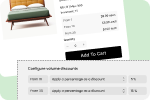Choose a blended store if you want simpler operations, lower costs, and a unified brand experience – especially when products overlap and your team is small. Choose a dedicated store if you need clear data separation, a distinct B2B brand, or deep customizations for wholesale buyers.
If you’re running a Shopify store that serves both direct-to-consumer (DTC) and wholesale buyers, you’ve likely encountered a critical decision: Should you operate a blended store or a dedicated store for your B2B operations?
In this comprehensive guide, you’ll discover the key differences between these two approaches, understand the advantages and limitations of each setup, and learn exactly which option aligns with your business needs.
What is a Blended Store?
A blended store is a single Shopify storefront that serves both your direct-to-consumer customers (DTC) and your B2B wholesale buyers simultaneously. Think of it as a unified approach where retail shoppers and wholesale clients access the same store, but with different experiences based on their login credentials and assigned permissions.

Key Benefits of a Blended Store
- Simplified Administration: Manage everything from one Shopify admin dashboard – no switching between multiple interfaces or reconciling separate inventories
- Unified Inventory Management: Real-time inventory visibility across all sales channels eliminates stock discrepancies and overselling risks
- Lower Operational Overhead: One store means one theme to maintain, one set of apps to manage, and fewer technical complexities
- Faster Setup: Get your B2B channel up and running quickly without building a separate storefront from scratch
- Consolidated Reporting: View all sales data, customer insights, and performance metrics in a single analytics dashboard
Limitations to Consider
- Limited Customer Segmentation: Customizing experiences for different buyer types becomes constrained by the shared storefront architecture
- Shared Visual Experience: Your wholesale buyers see essentially the same branding and design as retail customers, which may not convey the professional wholesale atmosphere you want
- Pricing Display Constraints: While you can offer custom pricing, managing complex pricing tiers or volume discounts requires more workarounds
- Checkout Complexity: Creating distinct checkout flows for retail vs. wholesale can be technically challenging in a single storefront
Visual suggestion: A simple diagram showing one Shopify storefront with two different user groups (DTC customers and B2B buyers) accessing the same platform with different permissions.

What is a Dedicated Store?
A dedicated store approach means creating a completely separate Shopify storefront exclusively for your wholesale operations. This B2B-focused store operates independently from your retail site, with its own domain, branding, and administrative interface.
Benefits of a Dedicated B2B Store
- Complete Customization Control: Design a wholesale-specific experience that matches professional B2B expectations – from navigation to product displays
- Specialized Workflows: Build order processes, approval systems, and account management flows tailored specifically for wholesale buyers
- Professional Branding: Establish a distinct identity for your B2B channel that reinforces your wholesale positioning and credibility
- Granular Pricing Management: Implement sophisticated pricing structures, volume discounts, and customer-specific catalogs without retail constraints
- Independent Optimization: Test, iterate, and optimize your B2B store without impacting your retail operations
Challenges of Running Separate Stores
- Multiple Admin Interfaces: Managing two (or more) Shopify stores requires switching dashboards and potentially duplicating efforts
- Higher Resource Requirements: You’ll need additional time, budget, and potentially team members to maintain separate storefronts
- Inventory Synchronization: Keeping stock levels accurate across stores requires careful management or third-party inventory sync tools
- Increased Subscription Costs: Operating multiple Shopify stores means paying for multiple subscriptions and potentially duplicate apps
Visual suggestion: A diagram illustrating two separate Shopify stores – one branded for retail consumers, another designed specifically for wholesale buyers – with distinct domains and interfaces.
Comparing Blended vs Dedicated Stores: Key Factors
Companies & Customer Segmentation
When evaluating the blended store vs dedicated store decision, customer segmentation capabilities should be your first consideration.
In a blended store, Shopify allows you to create company profiles and assign buyers to specific companies with location hierarchies. However, your segmentation options remain somewhat limited by the shared storefront architecture. You can show different products and pricing to different customer groups, but the underlying store experience stays largely consistent.
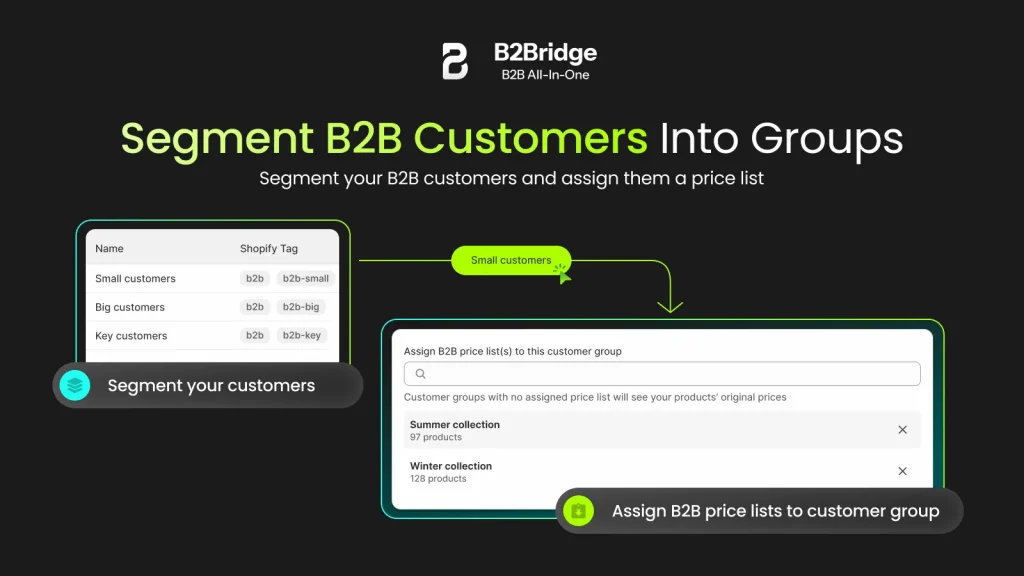
A dedicated store gives you complete freedom to segment your wholesale audience however you choose. You can create entirely different buyer journeys for small retailers versus large distributors, domestic versus international customers, or any other segmentation logic that serves your business model.
| Feature | Blended Store | Dedicated Store |
| Company profiles | Supported with basic hierarchy | Full customization possible |
| Customer grouping | Limited to Shopify’s built-in segmentation | Unlimited custom segmentation |
| Location-based management | Available but basic | Fully customizable per store |
| Management complexity | Low (single admin) | Higher (multiple admins) |
| Buyer experience differentiation | Moderate | Extensive |
Admin Management
The administrative experience differs significantly between these two approaches.
With a blended store, you benefit from unified administration. All orders, customer data, inventory levels, and analytics live in one place. This simplification reduces training time for your team and minimizes the chance of errors from managing multiple systems. You can see your complete business picture at a glance – total revenue, bestselling products, and customer trends across both channels.
Dedicated stores require you to manage separate admin dashboards for each storefront. While this creates additional complexity, it also provides operational separation that some businesses prefer. Your B2B team can focus exclusively on wholesale operations without retail distractions, and you can assign staff permissions more granularly based on their responsibilities.
Pros of unified admin (blended):
- Single source of truth for all business data
- Reduced training requirements
- Faster decision-making with consolidated insights
- Lower risk of data discrepancies
Cons to consider:
- Less role-based workflow separation
- Potential for retail and wholesale operations to interfere with each other
- More complex permission management when teams need different access levels
Branding & Customer Experience
Your store setup profoundly impacts how wholesale buyers perceive your brand and interact with your products.
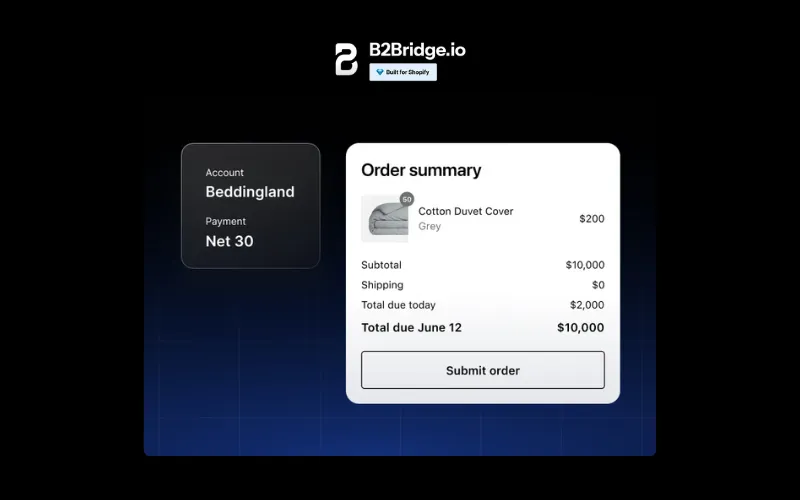
In a blended store, customization options are inherently limited. While you can modify certain elements based on customer tags or login status – such as hiding specific collections or adjusting navigation – you’re ultimately constrained by a single theme and design framework.
Your wholesale buyers essentially shop in a retail environment with B2B features added on top. For some businesses, especially those just starting with wholesale, this works perfectly fine. For others seeking to establish a premium wholesale brand, it feels insufficient.
A dedicated store unlocks complete UX/UI freedom for your B2B channel. You can design every aspect of the wholesale experience from the ground up – professional product catalog layouts, bulk ordering interfaces, account management portals, and streamlined reorder processes.
This level of customization helps you deliver the polished, efficient experience that wholesale buyers expect from their suppliers. You can incorporate industry-specific features, create custom product documentation displays, or build specialized tools that support how your particular buyers make purchasing decisions.
The customer experience difference often becomes most apparent in the checkout process. Dedicated stores allow you to create wholesale-optimized checkout flows that support manual review, approval workflows, credit limit checks, and other B2B-specific requirements without compromising your retail checkout experience.
Catalogs & Custom Pricing
Pricing management represents one of the most critical differences in the blended store vs dedicated store comparison.
Both setups support Shopify’s B2B features including custom pricing, but they implement these capabilities differently. In a blended store, you assign specific price lists to customer companies and use Shopify’s built-in volume pricing features. This works well for straightforward wholesale pricing models – standard wholesale discounts, basic volume tiers, or customer-specific pricing agreements.
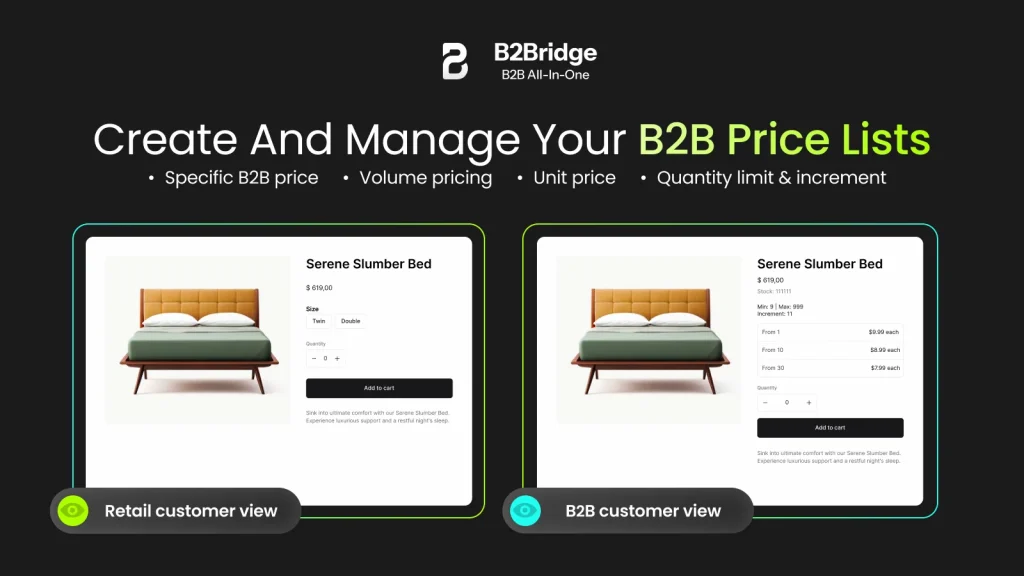
Dedicated stores offer more sophisticated catalog and pricing control. You can display entirely different product assortments to different buyer segments, implement complex tiered pricing structures that account for purchase volume and customer relationship history, and create promotional pricing that runs independently from your retail promotions.
| Pricing Feature | Blended Store | Dedicated Store |
| Custom price lists | ✓ Supported | ✓ Supported |
| Customer-specific pricing | ✓ Basic implementation | ✓ Advanced control |
| Volume discounts | ✓ Available | ✓ Highly customizable |
| Product visibility control | ✓ Limited | ✓ Complete |
| Tiered pricing structures | ✓ Moderate complexity | ✓ Unlimited complexity |
| Promotional independence | ✗ Shared with retail | ✓ Separate campaigns |
Payment Terms Flexibility
Modern B2B commerce increasingly requires flexible payment options, particularly Net payment terms (Net 30, Net 60, Net 90) that allow wholesale buyers to receive products before payment is due.
Shopify now supports Net payment terms in both blended and dedicated store configurations through Shopify Plus and compatible B2B apps. This represents a significant advancement for merchants who previously struggled to offer trade credit within the Shopify ecosystem.
How payment terms influence your business:
- Buyer Experience: Offering Net 30 or Net 60 terms removes purchasing friction for established wholesale customers and aligns with industry standards
- Cash Flow Management: Extending payment terms impacts your working capital, requiring careful cash flow planning and credit risk assessment
- Competitive Positioning: Payment term flexibility can be a differentiator when competing for wholesale accounts against other suppliers
- Order Value: Buyers often place larger orders when they can defer payment, increasing your average order value
In a blended store, you configure payment terms through customer company settings, applying specific terms to each wholesale account. Dedicated stores offer the same payment term functionality but with additional flexibility to create buyer-specific checkout experiences that emphasize available payment options.
Regardless of which store setup you choose, implementing Net payment terms requires careful consideration of credit policies, collections processes, and accounts receivable management.
Draft Orders & Wholesale Operations
Draft orders serve as a critical tool for B2B operations, allowing you to create custom orders on behalf of wholesale buyers, apply special pricing, calculate complex shipping, and send invoices for approval before finalizing purchases.
Both blended and dedicated stores provide full draft order functionality through the Shopify admin. Your team can build orders based on customer requests, negotiate pricing in real-time, and process offline agreements through your Shopify system. This ensures all transactions – whether self-service through the storefront or sales team-assisted – flow through your unified order management system.
The operational impact varies based on your store setup. In a blended store, draft orders for both retail and wholesale customers appear in the same order list, requiring careful filtering and organization. Dedicated stores naturally separate wholesale draft orders, making it easier for B2B-focused teams to manage their pipeline without retail order noise.
For high-touch wholesale businesses where sales representatives actively manage customer relationships and negotiate custom orders, dedicated stores often provide a cleaner operational environment. For businesses transitioning to self-service B2B or managing lower volumes of custom orders, blended stores offer sufficient draft order capabilities without added complexity.
How to Decide Which Setup Works for Your Business
Choosing between a blended store vs dedicated store ultimately depends on your specific business circumstances, resources, and growth strategy. Use this decision-making framework to evaluate which approach aligns with your needs:
Choose a Blended Store if:
- You’re launching wholesale for the first time and want to test the channel with minimal investment
- Your product catalogs are largely identical between retail and wholesale
- Simple pricing models (standard wholesale discounts) meet your needs
- You have limited resources for managing multiple storefronts
- Your wholesale and retail branding can share similar aesthetics
- Unified inventory management is a critical priority
- Your wholesale operation is a secondary revenue stream rather than core business focus
Choose a Dedicated Store if:
- B2B represents a significant portion of your revenue or growth strategy
- You need extensive customization for wholesale buyer experiences
- Your wholesale products, pricing, or catalog differ substantially from retail
- Professional, specialized branding for your B2B channel matters to your market positioning
- You have the resources to manage multiple Shopify storefronts effectively
- Complex pricing structures, custom workflows, or approval processes are business requirements
- Your wholesale and retail operations benefit from separate management and reporting
Additional considerations:
- Current business stage: Early-stage businesses often start with blended stores and transition to dedicated stores as wholesale grows
- Customer expectations: Research what your target wholesale buyers expect from their supplier’s ordering platform
- Technical capabilities: Assess your team’s ability to manage multiple stores or implement workarounds in a blended environment
- Budget constraints: Calculate the true cost of each approach, including subscription fees, apps, development, and ongoing maintenance
- Scalability needs: Consider where your business will be in 2-3 years, not just current requirements
Using B2Bridge for Shopify B2B Setup
Whether you choose a blended or dedicated store approach, B2Bridge provides the all-in-one B2B solution that optimizes your Shopify wholesale operations. As a comprehensive B2B app built specifically for Shopify merchants, B2Bridge enhances both store configurations with powerful features that address the unique challenges of wholesale commerce.
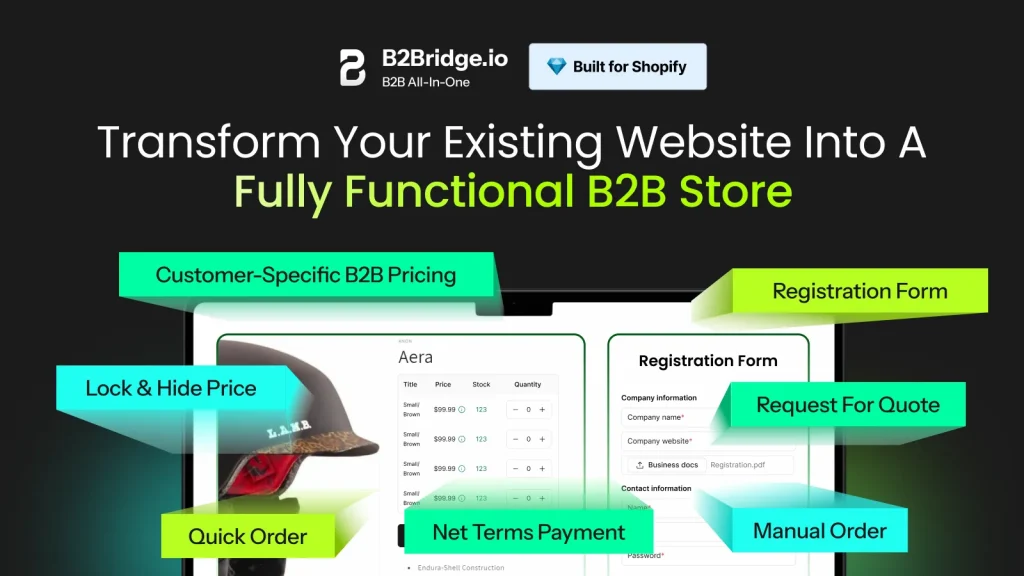
Why B2Bridge transforms your B2B operations:
- Simplify wholesale management: Streamline order processing, customer onboarding, and catalog management with intuitive tools designed for efficiency
- Protect your pricing: Implement sophisticated pricing controls, hide wholesale prices from retail customers, and create customer-specific price lists effortlessly
- Scale with confidence: Support growing order volumes and expanding wholesale customer bases without operational bottlenecks
- Save time on operations: Automate repetitive tasks, reduce manual order processing, and free your team to focus on relationship building
- Offer seamless buyer experiences: Provide self-service ordering, quick reorder capabilities, and professional account management portals that wholesale buyers expect
- Close more wholesale deals: Convert more prospects with flexible payment terms, custom catalogs, and streamlined purchasing processes
- Future-proof your store: Built on Shopify’s latest B2B infrastructure, B2Bridge evolves with the platform to ensure long-term compatibility
B2Bridge works seamlessly in both blended and dedicated store environments, giving you the flexibility to choose your store architecture based on business needs while still accessing enterprise-grade B2B functionality.
FAQs About Blended vs Dedicated Stores
A blended B2B Shopify store serves both retail and wholesale customers in one storefront using customer-specific pricing and access rules. A dedicated B2B store is a separate, wholesale-only site created exclusively for business buyers, often with custom workflows, catalogs, and checkout experiences.
An online store is a digital storefront where customers browse and purchase products through a website. A shop typically refers to a physical location where transactions happen in person. Online stores operate virtually, while shops provide on-site, face-to-face shopping experiences.
A business that sells through both physical locations and online channels is called an omnichannel or multichannel retailer. These businesses integrate offline and online experiences to offer customers consistent purchasing options across websites, brick-and-mortar stores, and other sales touchpoints.
A B2B store is an online storefront designed for business buyers instead of individual consumers. It typically includes features like bulk ordering, tiered pricing, payment terms, customer-specific catalogs, and account-based access tailored to wholesale or corporate purchasing needs.
Small to mid-sized businesses with straightforward wholesale needs typically thrive with blended stores. The simplified administration and lower overhead align well with limited resources. Larger businesses or those with substantial B2B revenue (30%+ of total sales) often find dedicated stores worth the investment due to the enhanced control and professional presentation they enable.
Yes, migrating from a blended to dedicated store (or vice versa) is possible, though it requires planning and execution. You’ll need to transfer product data, customer information, and configure the new store’s settings. Many merchants start with a blended approach and migrate to dedicated stores as their wholesale channel matures. Consider using migration tools or working with Shopify experts to ensure smooth transitions.
Conclusion
The blended store vs dedicated store decision shapes the foundation of your Shopify B2B strategy. Neither approach is universally superior. The right choice depends on your specific business context: your resources, customer expectations, pricing complexity, and growth ambitions. Many successful wholesale businesses start with blended stores and graduate to dedicated setups as their B2B channel matures – and that’s a perfectly valid evolution.
Ready to optimize your Shopify wholesale operations? Discover how B2Bridge can enhance your chosen store setup with powerful B2B features designed to help you sell more, operate efficiently, and deliver exceptional wholesale experiences. Explore B2Bridge today and take your Shopify B2B channel to the next level.

Hi, I’m Ha My Phan – an ever-curious digital marketer crafting growth strategies for Shopify apps since 2018. I blend language, logic, and user insight to make things convert. Strategy is my second nature. Learning is my habit. And building things that actually work for people? That’s my favorite kind of win.
